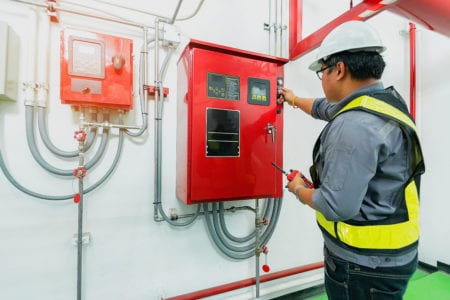Fire alarm maintenance is an essential task in any building or office, as regular inspections and tests help ensure the system works as it should in an emergency situation.
Select a provider with experience and qualifications. Professional inspectors and service technicians have the necessary skill sets to conduct extensive inspections that go beyond what can be accomplished through in-house staff alone.
1. Schedule Regular Inspections
Schedules for fire alarm inspections should depend on local regulations, facility type and system complexity. Monthly tests typically include visual checks to ensure control panels display normal operation with no visible signs of damage; smoke detectors and manual pull stations work correctly as expected, with alarm signals and battery backup systems responding as anticipated.
Quarterly inspections may include more in-depth evaluation of every device within your alarm system, from testing smoke and heat detector sensitivity to verifying alarms are audible and visible throughout the building or area covered by it. Furthermore, this test should check communication lines to monitoring services and fire departments to make sure they work effectively.
Annual tests should be more in-depth, covering every component in your system to make sure they can function as intended in an emergency situation. This may include performing sensitivity tests, verifying power supplies and reviewing any communications lines connected with it, as well as simulating fire incidents to make sure each sensor, alarm and manual call point responds properly during a full functional test.
2. Test the System Regularly
Failure of fire alarms to function during an emergency can result in delayed evacuation, increased risk of injury or death, and significant property damage. In many instances, however, these failures can be avoided with regular fire alarm testing and maintenance schedules.
An annual test involves conducting a comprehensive inspection of all of the fire alarm components, such as control panel, smoke detectors, heat detectors, manual call points and alarm sounders. This involves testing their response to signals generated by the system as well as their backup power source and communication lines.
The NFPA suggests using aerosol smoke detector spray to quickly and efficiently test sensor functionality, as this can quickly establish whether they respond to their respective test buttons. If one or more sensors prove unresponsive, replacement may be necessary.
Prior to initiating a fire alarm test, it’s vital that all building occupants know it is scheduled. This helps avoid panic or disruption of business activities during the test and also ensures everyone understands what to expect during it – this can be accomplished verbally or via signage.
3. Check the Battery Levels
Fire alarm systems play an integral part in keeping everyone informed of any issues within a building or space, from sounding loud sirens and flashing strobe lights, to quietly informing occupants where to go in case there’s an emergency situation. Unfortunately, like other electronic devices they can sometimes malfunction over time.
Most fire alarm systems come equipped with an instruction manual detailing how to troubleshoot common issues, with backup battery levels being one of the primary areas to keep an eye on; otherwise, your backup mode won’t work and could potentially halt operation of your alarm system altogether.
To check battery levels, a multi-meter with DC current reading capabilities should be used. Remove any jumper that links red and black wires of your battery (or disconnect power altogether), and observe its reading on your meter – it should read higher than the nominal charging voltage you recorded when first testing your system; this indicates good condition batteries that can serve as back-up backup as necessary. If it falls below this value, however, replacement should occur soon.
4. Replace Old Batteries
Fire alarm systems only function properly when all their components work in harmony, such as the fire alarm control panel which assesses signals from detectors and sends them on to emergency services. Other key system components include:
Notification appliances such as horns and speakers serve to notify occupants in case of an emergency situation. They may be activated manually with a pull station, or automatically by way of the fire alarm control panel.
Additionally, fire alarm control panels and devices must be powered by a power supply unit for backup power during outages. Such units provide both primary and backup power sources that ensure continuity for the entire system.
For optimal functioning of a smoke detector, its sensors must remain free of dust and pollutants. An occasional light dusting with a rag should suffice, but for deeper cleans every year a more thorough clean should take place. Set yourself a reminder on your phone or calendar for each fire alarm requiring new batteries; choose an easy date such as Memorial Day to help stay on top of this essential maintenance task.
5. Schedule an Upgrade
Fire alarm systems may often be repaired, but upgrading may become the more cost-effective option over time. Over time, components start wearing out even though they pass inspection. This increases maintenance costs and may make newer parts incompatible with one another.
Plan to replace all system components every 10 years for maximum longevity and compliance purposes. This ensures the life span of your system remains optimal while meeting requirements.
If your current fire detection system is Zoned, upgrading to an Addressable fire alarm system could provide more advanced perks – including remote access and easy expansion in the future.
Regular fire safety training, cleaning schedules and creating a culture of responsibility among building occupants can help minimize false alarms, helping maintain a safer working environment while decreasing evacuation fatigue costs and fines. Speak to an experienced fire protection company about ways you can lower false alarm rates or upgrade your system upgrade options.

